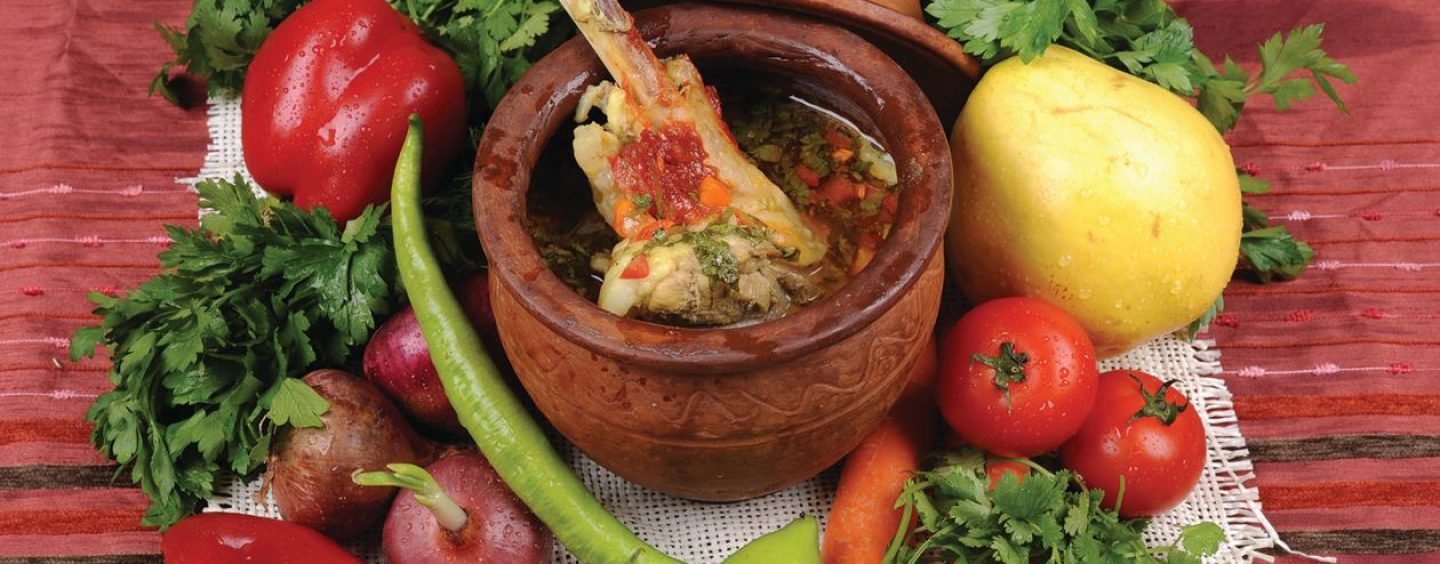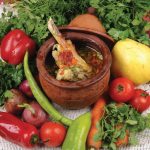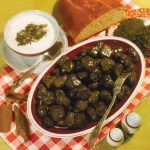Since in Azerbaijan there are 9 of 11 existing climatic zones, the nature has clearly taken care of us by providing our country with most diverse and tasteful fruits, vegetables and herbs, which are used in making different meals…
A famous Azerbaijani gastrologist Tair Amiraslanov believes that Azerbaijani cuisine is one of the most ancient and multifaceted in the world.
This cuisine is appealing both for meat eaters and vegetarians, those abiding by dietic nutrition and people that are fond of good, delicious and satisfying meal as well as connoisseurs of choice specialities. Throughout the year, Azerbaijani cuisine uses potherbs, vegetables and fruits. Combinations of spices, seasonings, dried fruits and herbs used in various dishes provide Azerbaijani meals with unusual flavor and beautiful appearance. Hence, while preparing a meal, it is very important to preserve its aesthetic beauty and a centuries-old culture of food consumption that has also produced the rite of its serving.
The Azerbaijani cuisine is rich with diverse regional traditions (those of Baku, Ganja, Sheki, Karabakh, Nakhichevan, Lankaran, Shemaha, etc.). Each region uses the kinds of groceries – fruits, vegetables and potherbs – of which they have the most. Where people have been surrounded with woods, for example, their food is known for abundant use of walnut, chestnut and hazelnut. Those living in the country’s steppe areas would frequently use meat of sheep and goats seasoned with various herbs, etc.
I would like to add, the Azerbaijani gastronomy is characteristic of sweet and sour type of flavors sourced in different fruits and spicy greens, and requiring but a scarce adding of salt. Playing an important role in Azerbaijan’s cuisine, pomegranate and fresh herbs accompany any meal.
You Are Welcome To All We Have!
Azerbaijani national food is very diverse; including dozens of types of various dishes that involve dairy, meat, flour, vegetables, etc. Food making techniques could be very different and diverse, too. In the past, meals could differ depending on people’s geographic locations and social status.
Major cuisine components were, usually, determined by natural conditions that gave rise to a broad use of lamb, poultry, river and sea (Caspian) fish as well as fruits and vegetables.
All this is accompanied with herbs, spices and seasonings like cinnamon, cloves, parsley, water cress (Vasari), green and black Reyhan (basil), dill, bitter pepper and bayberry, caraway seeds, coriander leaves, mint, saffron, sumach, etc.
The development of Azerbaijani cuisine was largely impacted by the precepts of Islam. As a result of Islamic tradition, it excludes dishes involving pork and alcohol.
Another feature of Azerbaijani cuisine has to do with sharp taste and matchless flavor contributed by all sorts of spices and herbs. But one should specifically consider saffron and sumach.
The first one is fundamental to the making of multiple pilafs. As a rule, sumach is used to complement various meat dishes.
It is interesting to note that some Azerbaijani dishes are cooked in special types of pots. The Piti soup is, for example, stewed in Piti pots; pilafs are cooked in thick-bottom kettles covered by special lids where live coals are placed to ensure the pilaf’s even “simmering.”
‘Saj’ is the name for a special kind of meat platter cooked on a frying pan that has a tiny brazier underneath.
Kebab and ‘Lula-Kebab’ are roasted on different kinds of skewers. First course is served in bowls called ‘Kasa’ as well as other similar utensils that other nations do not use…
KING PRESENT AT THE FEAST
Since the Azerbaijani cuisine is very filling, nutritious and full of calories, it is often jokingly called “men’s cuisine.”
It is interesting that pilaf is considered to be the most desirable and delicious meal of Azerbaijani cuisine. There are several kinds of pilaf: Kaurma Pilaf (one with lamb), Turshi Kaurma Pilaf (including lamb and sour fruits), Chii Doshama Kaurma Pilaf (lamb, pumpkin and chestnut), Toyug Pilaf (fried chicken pieces), Tarchilo Pilaf (regular or stuffed chicken), Chygyrtma Pilaf (chicken immersed in whipped eggs), Fisinjan Pilaf (poultry, nuts, sour fruits and cinnamon), Sheshrench Pilaf (egg-based), Sudlu Pilaf (milk-based) and Shirin Pilaf (fruity and sweet).
Unlike other cuisines, rice is cooked and served separately from the other elements of meat, fruits, etc.; and it is only on the table that they are combined and intermingled. There are certain traditions that rule serving and enjoying the taste of Azerbaijani pilaf.
The special dish of pilaf is served for honorable and “distinguished” guests, and at wedding feasts, where its appearance is accompanied with dancing, music and torch light. This ancient rite is extremely beautiful to watch…
The other well renowned part of Azerbaijani cuisine is Kebab or Shashlik – a moist and savory dish made of lamb and/or sturgeon roasted in chargrill or tandoor, and seasoned with a sour spice called Sumah. Also, Azerbaijanis admire Dolma – such as the one the Azerbaijan’s closest neighbors have always tried to call their “ancient Armenian” food.
The very word ‘Dolma’ has a Turkic origin and means “filled with something” … The most common meaning of “Dolma” implies grape leaves stuffed with ground beef. This classical type of Dolma is titled “Yarpag Dolmasi.” There are also other types of Dolma, i.e. when tomatoes, eggplants, bell peppers and cabbage are stuffed with meat (the latter dish resembles cabbage rolls, but it is also known outside of Azerbaijan!).
Another popular national dish – known as Gutab – is jokingly called Azerbaijani ‘fast food.’ It is a thin palm-size crescent-shaped patty that gets stuffed with ground meet and fried in boiling vegetable oil. There is also a vegetarian version of this dish, titled Keta, that is stuffed with spinach, cilantro, fennel, pomegranate seeds and grated white cheese.
The Azerbaijani cuisine is popular with various kinds of soups, including hot meat-broth called Piti; cold broth with sour milk (Dovga), with flour (Umach), and with meat balls (Kufta Bozbash), etc. The dining table must never lack salads made of fresh vegetables and potherbs, pickled products and two types of bread known as Churek and Lavash.
NOTHING BETTER THAN TEA!
In Azerbaijan, a filling meal is always followed by the matchless and favorite tea party. It is for this reason that various sweet delicacies and jams enjoy great popularity in Azerbaijan.
It should also be added that tea-plants grow in Azerbaijan to produce an excellent quality tea that is exported to other countries of the world. Such tea, needless to say, plays an important role in Azerbaijan’s national culture…
Usually, tea party table includes colored sugar pieces that careful housewives like to season with spices and nuts. Traditionally, the Azerbaijani people has always appreciated sweets and pastries, listing over 30 different kinds that include papaver, nuts, almond, caraway seeds, ginger, cardamon and many others. The most popular Azerbaijani sweets are, primarily, known as Pahlava, Shekerbura, Baku Kurabie, Badambura, Shekerchurek and many other dainties….
Every region of Azerbaijan has its own recipe of pahlava that can even look differently from those of other regions. These different types include a diamond-shaped classical pahlava (also called “Baku Pahlava”), the famous square Sheki pahlava, and a triangular pahlava of Gabala region titled “Uchgulag,” i.e. a “three-eared pahlava.”
In Azerbaijan, tea is customarily served together with fruit jams and conserves that are made of water melon, white cornelian cherry, fresh walnuts as well as the so called cherry-sized ‘paradise apples.’ The Azerbaijanis have so great an appreciation of jams and conserves that they even have a practice of making an olive jam. Also, the tea party always includes nuts, raisins, and pressed granulated sugar mixed with various kinds of syrups. Sweet dainties are, necessarily, enjoyed in copula with black tea served in special pear-shaped glasses titled ‘Armudi.’ This kind of glass impedes tea cooling process. One must not be surprised if offered tea before lunch as this Azerbaijani custom is an expression of household inhabitants’ hospitality and cordial kindness toward their guests…
YOU ARE WELCOME TO THE “FEAST OF TASTE”!
There is a good reason why Azerbaijan’s gastronomy has, since long ago, become popular both in the East and in Europe. This was evidenced in famous historians and travelers’ written accounts.
Azerbaijan’s culinary art of developing cooking recipes is based on a centuries-old history comprising many generations’ experience that has been meticulously accumulated and preserved to this day. It is no coincidence that our country is known to be inhabited by long-living people. Scientists explain this phenomenon by people’s lifestyle, the country’s favorable climate, environmentally sound food products and the use of proper diet principles. Coming to Azerbaijan from different countries of the world, most sophisticated gourmets get to enjoy the delicious taste and delicate flavor of Azerbaijani cuisine.
In every region of Azerbaijan, you will be said “Nush Olsun” or “Bon Appetite,” as you are extended warm welcome to partake of the banquet or real feast of taste.








